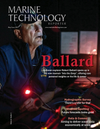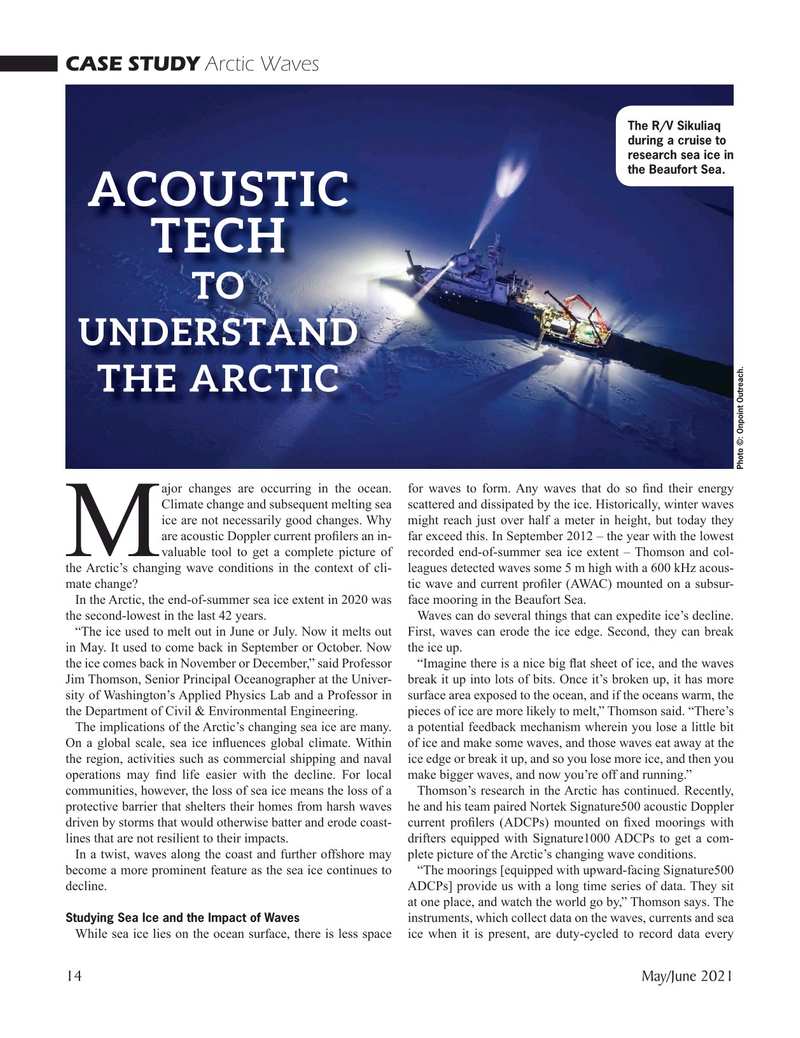
Page 14: of Marine Technology Magazine (May 2021)
Hydrographic Survey Sonar
Read this page in Pdf, Flash or Html5 edition of May 2021 Marine Technology Magazine
CASE STUDY Arctic Waves
The R/V Sikuliaq during a cruise to research sea ice in the Beaufort Sea.
ACOUSTIC
TECH
TO
UNDERSTAND
THE ARCTIC
Photo ©: Onpoint Outreach.
ajor changes are occurring in the ocean. for waves to form. Any waves that do so ? nd their energy
Climate change and subsequent melting sea scattered and dissipated by the ice. Historically, winter waves ice are not necessarily good changes. Why might reach just over half a meter in height, but today they are acoustic Doppler current pro? lers an in- far exceed this. In September 2012 – the year with the lowest
Mvaluable tool to get a complete picture of recorded end-of-summer sea ice extent – Thomson and col- the Arctic’s changing wave conditions in the context of cli- leagues detected waves some 5 m high with a 600 kHz acous- mate change? tic wave and current pro? ler (AWAC) mounted on a subsur-
In the Arctic, the end-of-summer sea ice extent in 2020 was face mooring in the Beaufort Sea.
the second-lowest in the last 42 years. Waves can do several things that can expedite ice’s decline. “The ice used to melt out in June or July. Now it melts out First, waves can erode the ice edge. Second, they can break in May. It used to come back in September or October. Now the ice up. the ice comes back in November or December,” said Professor “Imagine there is a nice big ? at sheet of ice, and the waves
Jim Thomson, Senior Principal Oceanographer at the Univer- break it up into lots of bits. Once it’s broken up, it has more sity of Washington’s Applied Physics Lab and a Professor in surface area exposed to the ocean, and if the oceans warm, the the Department of Civil & Environmental Engineering. pieces of ice are more likely to melt,” Thomson said. “There’s
The implications of the Arctic’s changing sea ice are many. a potential feedback mechanism wherein you lose a little bit
On a global scale, sea ice in? uences global climate. Within of ice and make some waves, and those waves eat away at the the region, activities such as commercial shipping and naval ice edge or break it up, and so you lose more ice, and then you operations may ? nd life easier with the decline. For local make bigger waves, and now you’re off and running.” communities, however, the loss of sea ice means the loss of a Thomson’s research in the Arctic has continued. Recently, protective barrier that shelters their homes from harsh waves he and his team paired Nortek Signature500 acoustic Doppler driven by storms that would otherwise batter and erode coast- current pro? lers (ADCPs) mounted on ? xed moorings with lines that are not resilient to their impacts. drifters equipped with Signature1000 ADCPs to get a com-
In a twist, waves along the coast and further offshore may plete picture of the Arctic’s changing wave conditions.
become a more prominent feature as the sea ice continues to “The moorings [equipped with upward-facing Signature500 decline. ADCPs] provide us with a long time series of data. They sit at one place, and watch the world go by,” Thomson says. The instruments, which collect data on the waves, currents and sea
Studying Sea Ice and the Impact of Waves
While sea ice lies on the ocean surface, there is less space ice when it is present, are duty-cycled to record data every 14 May/June 2021
MTR #4 (1-17).indd 14 5/27/2021 8:51:14 AM

 13
13

 15
15
